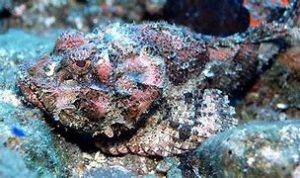
Scorpion Fish
The scorpionfish is a family of venomous fish known for their unique appearance and potent defensive capabilities. Here are some interesting facts about scorpionfish:
Appearance: Scorpionfish have a distinctive and often colorful appearance. They have a stocky body covered in bumpy, textured skin, which helps them blend into their surroundings. Many species have elaborate patterns or mottled coloration, providing excellent camouflage among coral reefs or rocky seabeds.
Venomous Spines: Scorpionfish possess venomous spines on their dorsal fins, which they use for defense. These spines contain venom glands at their base, and when threatened or disturbed, the fish can erect the spines to deliver a painful sting. The venom serves as a deterrent against predators and is primarily used for self-defense.
Diverse Family: The scorpionfish family, known as Scorpaenidae, is large and diverse, with over 200 recognized species. They are found in both tropical and temperate oceans worldwide, particularly in the Indo-Pacific and Atlantic regions.
Ambush Predators: Scorpionfish are primarily ambush predators, lying motionless on the seafloor and waiting for prey to approach. They have large mouths and can engulf relatively large fish or invertebrates that come within striking range. Their camouflage and patience make them highly effective predators.
Diet: Scorpionfish have a varied diet, feeding on a range of small fish, crustaceans, and other invertebrates. They have expandable jaws that allow them to engulf prey items larger than their own mouth size.
Camouflage: The coloration and pattern of scorpionfish help them blend into their surroundings, making them almost invisible to potential prey and predators. They can match the color and texture of their habitat, such as coral, rocks, or sandy areas, providing excellent camouflage and increasing their chances of capturing prey.
Bottom-Dwelling Habitats: Scorpionfish are typically found in coastal and reef environments, inhabiting rocky areas, coral reefs, seagrass beds, and sandy or muddy seabeds. They often prefer to stay close to the seafloor, where they can hide and ambush their prey.
Reproduction: Scorpionfish have internal fertilization, and females produce eggs that are fertilized by males. After fertilization, the female may carry the eggs in a specialized brood pouch until they hatch. The hatched larvae then go through a pelagic stage before settling on the seafloor and developing into adults.
Importance in Coral Reef Ecosystems: Scorpionfish play an important role in coral reef ecosystems as top predators. They help control populations of smaller fish and invertebrates, contributing to the overall balance and health of the reef community.
Human Interaction: Scorpionfish stings can be extremely painful and, in some cases, dangerous. When diving or snorkeling, it is essential to exercise caution and avoid touching or stepping on these venomous fish. If stung, immediate medical attention is advised to manage the symptoms and reduce the risk of complications.